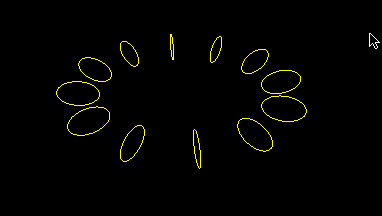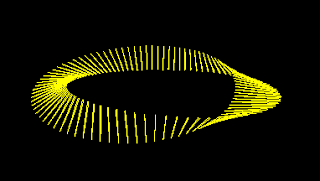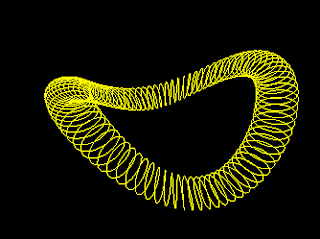I found a good mathematical resource for OpenGL from Cambridge University:
https://www.cl.cam.ac.uk/teaching/1718/AdvGraph/Printable%20(1-up).pdf

This is a simplified version of earlier program, hopefully to reduce unnecessary clutter:
https://gist.github.com/tthtlc/3ee685f66a6addc4082fde0a65b860fa
And instead of a circle, which is drawn as a polygon of 30 sides, we can fixed it to TWO-gon:
And instead of a circle, which is drawn as a polygon of 30 sides, we can fixed it to TWO-gon:
The rod-shaped structure formed a flat surface - with top and bottom surface.
How to make it into a Mobius surface? So what if now the generator of the 2gon is shifted by a angle offset as it goes round the circle - and the total angular offset should total 180 degrees?
This is the result:
And the source code is here:
https://gist.github.com/tthtlc/9db1b5a9609932a75f70f0d347b62228
Instead of a 2-gon, why not change it to a 3-gon (triangle) and you will get this:
And the source code is here:
https://gist.github.com/tthtlc/43294d2f4346d5da834ad6aa6278dd13
And what if you make the circles move in a sinusoidal pattern around at the periodic frequency of 2?
The above is the result:
https://gist.github.com/tthtlc/5cc6268e7e8aa0f0025405557951f890
And in case you think the single colored rings are too boring:
https://gist.github.com/tthtlc/7245d5b53513fe13966eca1758921826
How to make it into a Mobius surface? So what if now the generator of the 2gon is shifted by a angle offset as it goes round the circle - and the total angular offset should total 180 degrees?
This is the result:
And the source code is here:
https://gist.github.com/tthtlc/9db1b5a9609932a75f70f0d347b62228
Instead of a 2-gon, why not change it to a 3-gon (triangle) and you will get this:
Instead of triangle (ngon=3) or circle earlier (ngon=30), what if we want to form helix? Then instead of drawing circle by itself, we need to rotate the circle while drawing the circle, forming this:
https://gist.github.com/tthtlc/43294d2f4346d5da834ad6aa6278dd13
And what if you make the circles move in a sinusoidal pattern around at the periodic frequency of 2?
The above is the result:
https://gist.github.com/tthtlc/5cc6268e7e8aa0f0025405557951f890
And in case you think the single colored rings are too boring:
https://gist.github.com/tthtlc/7245d5b53513fe13966eca1758921826











